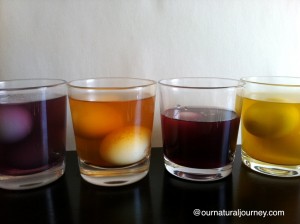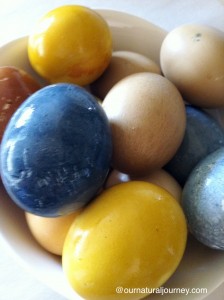Our Easter eggs — made with natural dye
| April 8, 2012 | Posted by eryn under Kids, Natural Living, Organic |
Happy Easter! This year is the first time I’ve tried dyeing eggs using foods and I have to say I’m pretty pleased with the results. It’s not quite as much fun making them as using the toxic stuff I used as a kid, but this way we don’t have to worry about what’s getting into our eggs. And I like the pale, natural colors.
Here’s what we did:
 Place eggs in a single layer in a pan and cover the eggs with water.
Place eggs in a single layer in a pan and cover the eggs with water.- Add 1 tsp. of vinegar and dye materials.
- Bring water to a boil.
- Cover, turn off the heat and let sit for 15 minutes.
- Remove the eggs from the liquid and place in another container.
- Strain the dye liquid and cover the eggs with the strained liquid.
- Place the eggs and liquid in the refrigerator overnight.
Since this process involves a lot of boiling water, my son did not participate in the egg coloring this year. I’m hoping as he gets older, he’ll be able to participate more. This process does take a lot more time, pots and pans, and refrigerator space than using traditional dyes. But it’s kind of cool to see the colors changing with time. It’s good to be patient sometimes.
 Here’s what we used to achieve our colors:
Here’s what we used to achieve our colors:
- Pale blue: 100% organic grape juice
- Blue: organic blueberries, red cabbage leaves, 100% organic grape juice
- Green: organic spinach, broccoli
- Greenish yellow: red cabbage leaves, turmeric
- Yellow: orange peels, lemon peels, cumin, turmeric, green tea
- Brown: instant coffee
- Orange: yellow onion skins, carrots, paprika, chipotle chili powder
I was especially happy with how the green, blue, yellow and brown colors turned out. I had added broccoli to the spinach mixture at the last minute because the water seemed so pale that I didn’t think it would dye the eggs at all. The greenish-yellow was a little too bright for me and the orange is not very bright. I think I would skip the greenish-yellow mixture next time and try adding more materials to the orange mixture to deepen the colors. Next year, I’d also like to try beets for a red or pink color.
Sorry this post is a little late. I’m sure everyone has their Easter eggs colored by now, if you’re doing that, but I wanted to let you know how ours turned out. I had waited until the last minute because I’d read a review online that had discouraged me from trying the natural dyes, but I decided to try them out for myself once. I’m so glad I did! We already had most of the dye materials on-hand, so the cost was fairly minimal, too.
If you’re looking for more ideas for natural Easter egg colors, there’s a fairly extensive list of options here.
Did you color Easter eggs this year? What did you use?





Here is what we used http://www.livingcrunchy.com/2012/04/make-your-own-egg-dye/
Those are such pretty eggs! Thank you for sharing.